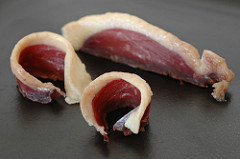Book Review: Kitchen Sense

Photo by Melissa Schneider.
When I flipped through my review copy of Mitchell Davis's Kitchen Sense (which I think came independently of the Cookbook Spotlight coincidentally highlighting it), Melissa noted its similarity to Mark Bittman's How to Cook Everything. Both feature a similar layout, a vast collection of recipes, and a can-do approach meant to calm the fretful home cook. While Bittman's recipes seem more modern, Davis's recipes seem closer to traditional European cuisines, and Davis doesn't rely on a blatant lie for a gimmicky title. Davis's book offers the next step for the Bittman devotee, but won't add much for those who worship at the shrine of Judy Rodgers.
Most reviewers might try the dishes they could make in a night: I homed in on the duck ham, which requires a week-long cure in the refrigerator. (I'm hoping one of you can explain to me why a salt-cured duck breast shares a name with a salt-cured pig's leg; salt-cured beef loin becomes bresaola, not "cow ham.") The best way to make duck ham is to cure it in the refrigerator and then hang it in a cool, humid area to dry for a couple of weeks, but Davis isn't aiming for that crowd. I should note that Davis's technique is simplicity itself: Bury duck breast in salt and sugar, leave in the refrigerator for one week.
When I extracted the now rock-hard magret from the sludgy brine that formed in the container, I knew I had a winner. The meaty portion has a rich, surprisingly delicate duck flavor, and the fat portion tastes just like foie gras. As Davis says, you can use the mouthwatering treat anywhere you might use prosciutto. I've been carving off thin slices each night this week. He says you can use a normal duck breast, but once you use the breast of a foie gras bird, I don't imagine you could go back to the cheaper cut. I'll certainly make this ham again, but I'll probably diminish his spices and use regular sugar instead of brown sugar. I'd also encourage you to rinse the salt-and-spice encrusted ham and pat it down with paper towels, a step Davis omits for the cured breast. Otherwise, the seasoning on the meat's surface will be too strong.
I didn't disagree with his duck confit technique, but at least one item caught my quibbling eye. For risotto, he has you season the stock, and then leave it to simmer while you make the rice and eventually add cheese. I would argue that if you season the stock beforehand and let the water evaporate, you run the risk of overseasoning your risotto, especially with a salty cheese added at the end.
The book has "Kitchen Sense" call-outs that explain a technique or communicate some useful information. As with the recipes, new cooks will learn a lot from these well-written asides while experienced home cooks will skim.
Other reviewers noted the lack of pictures, but this doesn't bother me. Unless the photo showcases a pretty plating or illustrates a technique, I'm happy to have more text.
- Good Books For Cooking Technique
Lenn asked me for recommendations for technique-oriented cookbooks. I gave him some ideas and decided to share the list. The following books have given me skills and knowledge that I use every day in the kitchen. I love European food, and these books...
- Comparing Duck Legs
Photo by Melissa Schneider. Having made batch after batch of duck confit in the last few months, I'm convinced that legs from foie gras ducks produce a superior product. However, that limits your purchasing options—there are only four foie...
- Imbb 26/wbw 21: Duck Confit With Two Wine Pairings
Duck Confit with Fava Beans, Fingerling Potato Medallions, and Garlic Scapes Photo by Melissa Schneider. If this were a physical auditorium instead of a virtual one, and I asked you to name my favorite food, a few thousand hands would shoot up....
- Schneider Household Math
Photo by Melissa Schneider. To confit 24 legs from ducks raised for foie gras, you need six pounds of rendered duck fat. Trimmed fat from 24 foie gras duck legs yields three to four pounds of rendered duck fat. Confit fat can be used twice. Therefore,...
- Relearning Duck Confit And My Recipe Philosophy
Duck Confit... I love duck confit, legs (usually) salt-cured and cooked slowly in fat. I order it whenever I see it; I try different recipes at home. But the duck confit at Jojo is my benchmark. I rarely find duck confit as good as Curt's, even when...
